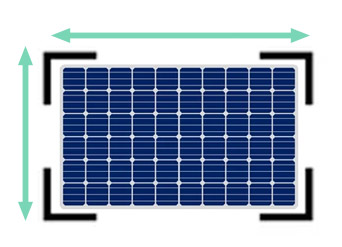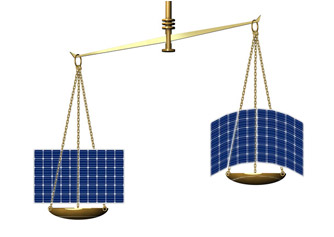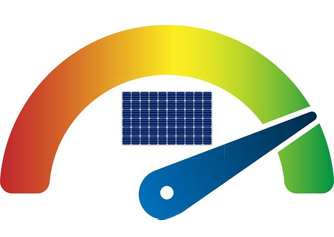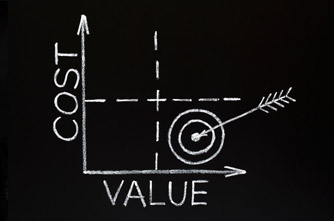In the last ten years, the United States has seen the use of solar grow annually by an average of 49%. This growth in the use of solar has led to a drop in price, making them far more accessible. As they have become more popular, people have begun looking at alternatives to the traditional panels. Flexible solar panels are a newer technology with quite a few advantages.
Flexible solar panels are a good option for RVs due to their lightweight and easy installation. They can be mounted on curved surfaces and provide power for appliances while on the road. However, they are less efficient and may not last as long as traditional rigid panels.
There are a number of differences to take into account when considering the use of flexible solar panels over more traditional rigid panels. In this article, we will discuss how flexible solar panels work and how they compare to the more popular panels in terms of cost, size, and durability.
What Are Flexible Solar Panels?
Flexible solar panels are a type of
SaveOnEnergy made a great infographic that resume how they work, have a look if you want to know more.
Flexible solar panels have evolved over time, with early versions made with thin film technology that was less efficient than traditional rigid panels. In recent years, advancements in organic silicon cells have made flexible panels more efficient and cost-effective.
Indeed, the scientist Ayodhya Tiwari and his team recently set a new records of 22.2% efficiency for flexible solar cells. (Source: admin.ch)
Today, flexible solar panels are used in a variety of applications, including on boats, RVs, and portable solar power systems. They are lightweight, easy to install, and can be mounted on curved surfaces, making them a versatile option for generating solar power.
Traditional Panels vs. Flexible Panels
The obvious difference between the two different types of panels is their physical make-up. Traditional panels are heavy, rigid, and require a stable structure and mounting in order to be installed and used. Whereas flexible solar panels can be tucked away when not in use, and are very easy to use, as shown in the video below of a campsite set up:
Let’s take a look at how flexible solar panels work in comparison to traditional panels and explore how they might be a good or bad option, depending on the situation.
| Flexible Panels | Traditional Panels | |
|---|---|---|
| Size | ||
| Weight | ||
| Installation | ||
| Efficiency | ||
| Durability | ||
| Cost | ||
| Total | 3 | 3 |
As you can see, flexible panels and traditional panels have an equal number of advantages and disadvantages.
It’s worth noting that the specific advantages and disadvantages of each type of panel may vary the specific product being compared. Ultimately, the choice between flexible and traditional panels will depend on factors such as the available space, the desired level of efficiency, and the budget for the project.
Here’s more explanation for each characteristics:
Size
![]() Winner: Flexible Solar Panels
Winner: Flexible Solar Panels

Most residential solar panels are 65 by 39 inches (1651 x 990 mm) and have a frame thickness somewhere between 1.25 inches (32mm) and 1.6 inches (40mm). The larger size of these rigid panels usually means they need to be mounted in place and take up a lot of room. It is possible to mount on the roof of a van, but these are not ideal for use in camping. However, for your home, larger panels offer a more consistent output than flexible panels of a similar size.
Flexible panels come in a variety of sizes, giving you more options and better versatility. These will be the far better option for portable solar energy. When camping, they can be quickly set up for use with simple electronics.
Weight
![]() Winner: Flexible Solar Panels
Winner: Flexible Solar Panels

Due to their size and efficiency, traditional solar panels are quite heavy. Running on average at 40 pounds (18 kg), they are not designed to be portable. They generally need a solid roof structure onto which they can be mounted, and when considering for use at home, that is not a one-man job.
By contrast, even larger flexible panels weigh less than 12 pounds (5kg). This makes them portable and convenient for use on the road. Similarly, the semi-flexible panels can be mounted onto a camper van or tiny house, without the fear of adding too much weight to your vehicle or trailer, which may be subject to road specifications in certain areas.
Installation
![]() Winner: Flexible Solar Panels
Winner: Flexible Solar Panels
As mentioned, rigid panels are quite heavy, and you must take into account the roof structure before installation. In addition, they generally require a team of professionals to ensure correct mounting and safe connection to the home’s power, which is the reason for their higher prices.
The video above perfectly demonstrates how easy flexible panels are to install. They can be moved and placed in the sun wherever you are. For the semi-flexible options, the video below demonstrates how they can be installed without the need for power tools:
These panels are far more user friendly and require little DIY know-how. Once installed, you can more or less forget about them.
Personal tips: flexible solar panels are easy to install and I recommend these adhesives for the best results.
Efficiency
![]() Loser: Flexible Solar Panels
Loser: Flexible Solar Panels

Unfortunately, this is where flexible panels come up short.
Traditional monocrystalline panels can produce anywhere from 16-25% efficiency, where the flexible counterparts run around 7-15%. That is quite a big difference and could be a deciding factor when looking into flexible panels.
Due to their lower efficiency rates, you will find that you need more flexible panels than if you opted for the rigid panels.
On the road, storing rolled up panels, or having them on the roof for the few items you need to charge, is easy enough and convenient. However, if you are looking at solar for energy for an RV or tiny house, or when considering home solar, you may find that you don’t have enough roof space to hold all of the flexible panels required to produce enough energy for a household.
Furhermore, flexible solar panels that sit directly on the roof can overheat by accumulating more heat than rigid panels with airflow around them, which reduces their efficiency and lifespan. Though there are mounting techniques to allow airflow beneath them, they may not be as convenient as peel-and-stick installation.
Durability

![]() Loser: Flexible Solar Panels
Loser: Flexible Solar Panels
In order to maintain their flexibility and low weight, flexible panels do not have a frame or glass coverage, leaving them much more prone to damage. Another issue for the semi-flexible panels is overheating. As they do not have mounts, but rather are fixed onto a surface – such as a van – there is little to no airflow. This can cause hotspots that can damage the cells and significantly reduce the life span of the panel.
Where rigid panels typically are built to last anywhere between 25 and 30 years, flexible panels generally have a much shorter warranty and life-span. According to SpiritEnergy, you may find your panel only lasts between 1-2 years. This is due to the stress put on these panels as they are moved around and bent repeatedly.
Cost

![]() Loser: Flexible Solar Panels
Loser: Flexible Solar Panels
Depending on their size, flexible solar panels can cost anywhere from $100 to more than $1000. When looking to use solar on a camper van, tiny house, or when camping, they are a cheaper alternative to the bulky, expensive rigid panels.
However, when looking at installing solar on your home, you may be surprised at the overall cost. Greenmatch estimates an installation cost of £7,000-£9,000 ($9,000-$11,500) for 20 panels on 32 square meters (38.27 square yards) for traditional panels.
In contrast, for the installation of flexible solar panels on space over 30 square meters (35.88 square yards), you would need more than 35 panels at the cost of £5,000 to as much as £20,000 ($6,500 – $25,000).
Conclusion
Depending on your intended use, flexible solar panels might be the best option for you. These lightweight, inexpensive panels can be rolled up for easy storage, making them an excellent choice for campers and travelers.
However, when looking into solar for your home, traditional panels may end up costing you less in the long run. Similarly, with a shorter life span, you will find yourself replacing your flexible panels far more often than the traditional panels.
| Flexible Panels | Traditional Panels | |
| Size | Variety of sizes | Average 65×39 inches (165.1×99.1 cm) |
| Weight | Less than 12 pounds (5.44 kg) | 40+ pounds (18.14+ kg) |
| Installation | Easy to DIY | Costly, labor-intensive |
| Efficiency | 7-15% | 16-25% |
| Durability | Life span of 1-2 years | Life span of 25-30 years |
| Cost | The cheaper option for camper vans and travelers.Higher cost to install at home | High initial cost when including installation |
